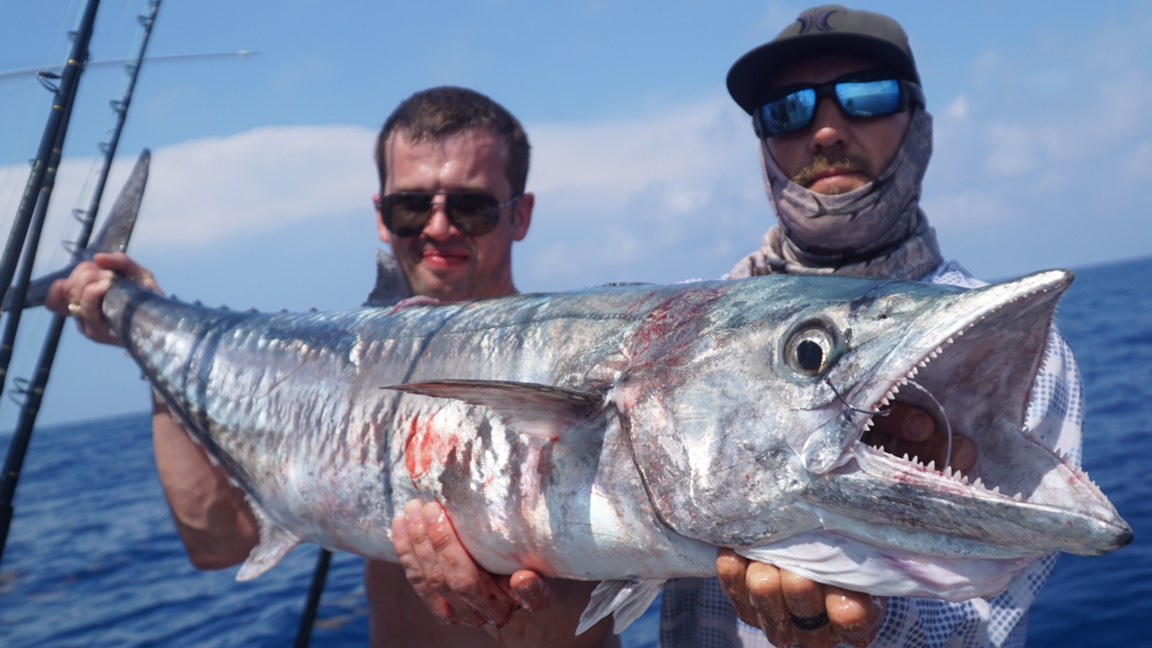Planer Fishing for Kingfish
Kingfish at a Glance
Kingfish are always a welcomed gamefish while fishing in tropical waters. They fight hard and are great to eat. Kings are present in South Florida year round with bigger fish around during the cooler months. We catch kings every month of the year using a variety of techniques. You can find more information on kingfish here: Kingfish Species Information
When you look at the anatomy of a kingfish you will notice distinct characteristics that are evident for all fish in the mackerel family. With long slender bodies, these fish are designed for bursts of speed. King mackerel lack the stamina of tuna and billfish but they are excellent hunters. They have razor sharp teeth and "slash" baits while they are hunting. This approach usually cuts their prey in half, killing it instantly. If baits are near the surface kings will sometimes "air out" on the bite. I have seen kings jump as high as 15 feet out of the water on kite baits. They sometimes circle back around and strike the bait multiple times until they have a direct hit. Kings frequently miss the bait on their first try but they will almost always come back for more. They strike fast but after cutting the bait kings often circle back around and eat the chunks. After striking a bait at 20 miles per hour I have watched them swim up to the remnants and sit motionless before finishing their meal. They are known for aggressive strikes but they can also be careful, nimble hunters.
When you look at the color patterns of kingfish they are mostly grey and silver. Their backs can look dark grey from above which helps them blend into dirtier water. Kingfish are a great game fish because of their abundance in a variety of conditions. Unlike sailfish for that prefer dark blue water and strong current, kingfish are happy to swim around in lighter current and dirtier water. Some of our best days of king fishing have been in powder or even green water. Sometimes it doesn't seem to matter if the current is moving north or south. These are resilient fish that will prowl the reefs regardless of the conditions.

When and Where to Catch Kingfish.jpeg)
When narrowing down where to fish for kings, we prefer water in 80-180 feet. I have caught kings in water as deep as 350 feet but it is rare that they venture out far from the reef. Kings tend to congregate in areas with an abundance of bait and structure. Sewage treatment outputs, shipwrecks, reefs, and drop offs are all great places to focus your efforts. Live baiting for kingfish is highly effective, especially for big fish. The downside however is that you don't cover as much ground and sometimes you'll get fewer bites if the fish are spread out.
Because of their sharp teeth, it is common practice to use stainless steel wire or titanium leaders while targeting kings. Since kings are known to be sloppy eaters, most rigs consist of more than one hook. "Stinger hooks" and double hook rigs for strips or ballyhoo help increase the hookup ration on kingfish. Instead of relying on drop backs and multiple strikes, more than one hook can help you hook kings on the first bite.
Our favorite technique for targeting kingfish is usually planer fishing. Kings feed near the surface during low light conditions (early morning and afternoon) as well as days that are overcast. Otherwise, kings usually swim in the middle of the water column. When the surface bite shuts off, most of your bites will be on the mid bait and bottom rod when live baiting. When planer fishing, the bait stays in the strike zone during all hours of the day. You can also cover a lot more water looking for schools of fish.
Trolling for Kingfish
Planer fishing can be deadly for kings and is actually the method of choice for many commercial fishermen. Before reading on, make sure you familiarize yourself with planer fishing by taking a look at our Planer Fishing Basics article. When targeting kingfish, we always troll a little bit slower than usual. For many species, 6-8 knots is fine. For kings, 3-5 knots seems to be the sweet spot. When we are live baiting for kings we use wire but while planer fishing we actually leave our faith in monofilament leaders. Kingfish are notorious for "short strikes" where they cut the bait in half or bite off the tail section. By incorporating long shank hooks, we catch most of our kings on monofilament leaders without getting cut off. Below are a few of the essentials for a standard planer spread.



While trolling for kings we use 80lb monofilament leaders and put a ball bearing swivel to prevent line twist. As baits, drone spoons can be deadly. We usually match the spoon to the water color. In addition to spoons, single or double hook rigs with strips of bonito work very well. We usually drape a sea-witch or king buster over the top of the strip. This helps it swim naturally without washing out. Wind your rigs onto yo-yos at the end of the day. Always put the hook or lure on the yoyo first and wind the rig on tight. If you want to re-rig fresh leaders for every trip, I recommend loading up on Bullbuster Fishing Line.
When planer fishing we like to work structure and always pay attention to the sonar. You can usually see schools of bait and even make out kings on the sonar if you have a 1kw transducer or better. If you see fish or get a bite, circle the area. I have caught over 10 kingfish in a small area more times than I can count. Be thorough if you see bait or are getting bites. If you aren’t getting bites, move on. Try to find concentrations of fish and you’ll be rewarded.
‹ Back











Comments